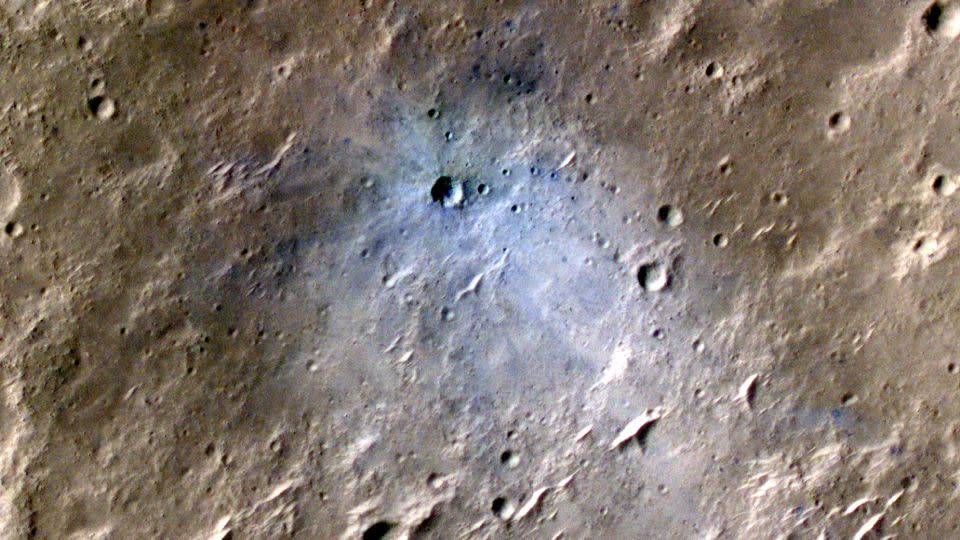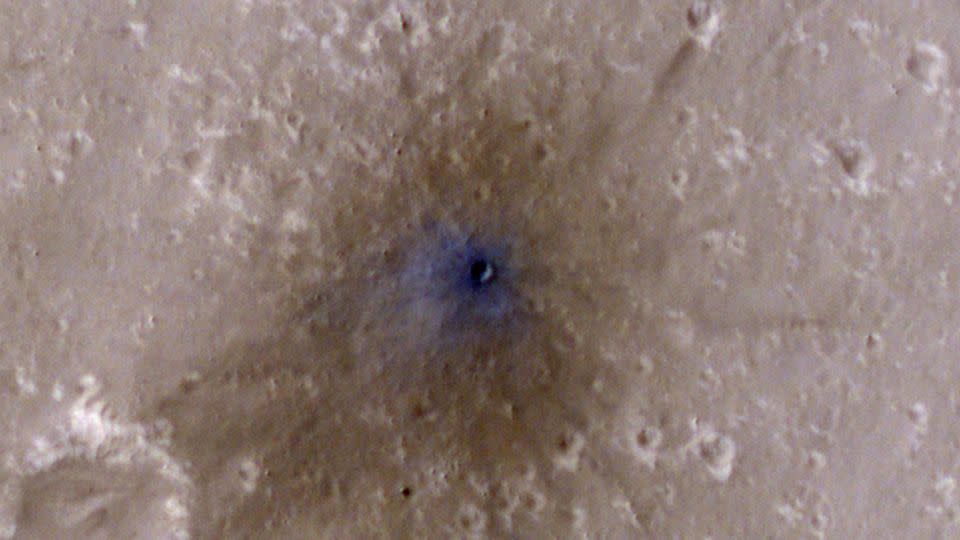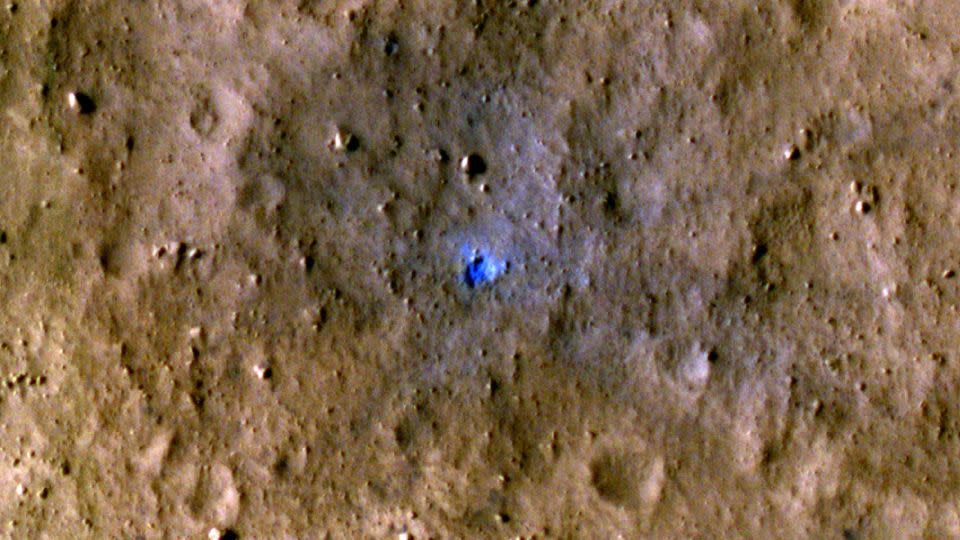Sign up for CNN’s Wonder Theory science newsletter. Explore the universe with news about fascinating discoveries, scientific developments and more.
Hundreds of basketball-sized space rocks crash into Mars every year, leaving impact craters and rumbling across the Red Planet, according to new research.
Mission planners can use the revelations, captured in data collected by a now-abandoned NASA mission, in determining the landing site for future robotic missions and astronaut crews on the red planet.
NASA’s InSight mission ended when the stationary lander lost its battle against a buildup of Martian dust on its solar panels in December 2022. But the spacecraft’s trove of data continues to yield new research findings.
The lander brought the first seismometer to Mars. The sensitive instrument could detect seismic waves thousands of miles away from InSight’s location in Elysium Planitia, a smooth plain just north of the planet’s equator.
During its stay on Mars, InSight has detected more than 1,300 marsquakes with its seismometer. These earthquakes occur when the Martian subsurface cracks due to pressure and heat.
But InSight also captured evidence of meteorites hitting Mars.
Meteoroids are space rocks that have broken off from larger rock bodies and range in size from dust grains to small asteroids, according to NASA. While they are still known as meteoroids in space, they are called meteors as they streak through the atmosphere of Earth or other planets.

Scientists have wondered why more impacts haven’t been detected on Mars, since the planet is located next to our solar system’s main asteroid belt, where many space rocks emerge to hit the Martian surface. Mars’ atmosphere is only 1% the thickness of Earth’s atmosphere, meaning more meteorites shoot through it without breaking up.
A meteoroid struck the Martian atmosphere on September 5, 2021, before exploding into at least three shards, each leaving a crater on the red planet’s surface. And it was just the beginning.
Looking for fresh craters
Since 2021, researchers have studied InSight data and found that space rocks bombard Mars more often than previously thought. According to a new study published Friday in the journal Science Advances, space rocks are two to 10 times more common than previously thought.
“It’s possible that Mars is more geologically active than we thought, which has implications for the age and evolution of the planet’s surface,” said study lead author Ingrid Daubar, associate professor of earth, environmental and planetary sciences at Brown University, in a statement. “Our results are based on a small number of samples at our disposal, but the estimate of the current impact rate suggests that the planet is being hit much more often than we can see with imaging alone.”
The team identified eight new impact craters created by meteoroids based on InSight data that orbiters orbiting the planet had previously spotted. Six of the craters were located near InSight’s landing site, and two of the distant impacts were some of the largest ever observed by scientists observing the red planet, according to the study.


Each of the two major impacts left craters the size of football fields, 97 days apart.
“We expect this magnitude to happen once every few decades, maybe even once in a lifetime, but here we have two just over 90 days apart,” Daubar said. “It could just be a crazy coincidence, but the chances of it being just a coincidence are very slim. What is more likely is that the two major impacts are related, or that the impact rate for Mars is much higher than we thought.”
The team compared the data collected by InSight with that of NASA’s Mars Reconnaissance Orbiter to determine where the impacts occurred. Before and after images allowed the team to confirm eight of the craters. It’s possible that InSight recorded more impacts during its mission, and the team plans to continue sifting through the data and looking for evidence of fresh craters in orbit.
“Planetary impacts are happening all the time throughout the solar system,” Daubar said. “We’re interested in studying that on Mars because we can compare and contrast what’s happening on Mars with what’s happening on Earth. This is important for understanding our solar system, what is in it, and what the impactor population in our solar system looks like – both as a hazard to Earth and historically to other planets.”
Tracking seismic signals
A companion paper, published Friday in the journal Nature Communications, also examined seismic events recorded by InSight to determine that basketball-sized meteoroids crash onto Mars almost daily.
Between 280 and 360 meteoroids hit the Red Planet each year, forming impact craters larger than 8 meters in diameter, according to the study. Larger craters of up to 30 meters occur about once a month, the study authors said.
“This rate was about five times higher than the number estimated from orbital images alone,” said co-lead study author Dr. Géraldine Zenhäusern, a professor of seismology and geodynamics at Switzerland’s ETH Zurich, in a statement. “In line with orbital images, our findings show that seismology is an excellent tool for measuring impact rates.”
By analyzing seismic events traced to meteoroids, the team identified approximately 80 InSight-recorded Marsquakes that may have been caused by impacts. The Marsquakes caused by meteoroid impacts occur at a higher frequency and last shorter than other Marsquakes caused by underground activity.


“While new craters are best seen on flat, dusty terrain where they really stand out, this type of terrain covers less than half of the Martian surface,” Zenhäusern said. “However, the sensitive InSight seismometer could hear every impact within range of the landers.”
According to the researchers, seismic data from the smallest ground movements on Mars could be the most direct way to understand exactly how many impacts are happening on Mars.
“By using seismic data to better understand how often meteorites strike Mars and how these impacts alter the surface, we can begin to piece together a timeline of the red planet’s geological history and evolution,” said co-lead study author Dr. Natalia Wojcicka, research associate in the Department of Earth Sciences and Engineering at Imperial College London, said in a statement. “You could think of it as a kind of ‘cosmic clock’ that helps us date the surfaces of Mars, and perhaps later other planets in the solar system.”
For more CNN news and newsletters, create an account at CNN.com